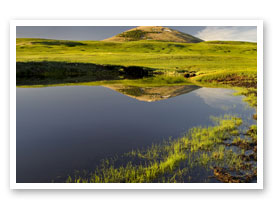 INSTITUTE FOR NATURAL RESOURCES
INSTITUTE FOR NATURAL RESOURCESYou are here
Wetlands
- Intro
- Planning Resources
- Research Projects
- Articles & Stories
- Maps & Tools
- Reports & Publications
- Data
- Photos & Videos
- More
Ecology of Wetlands
While it is easy enough to describe different types of wetlands, understanding their inner workings is much more difficult. As in any ecosystem, organisms are simultaneously interacting with each other as well as with the physical components of climate, water, soils, and geochemistry. Each of these components has its own complex of entities and a web of chemical, physical, and biological processes.

Zumwalt Prairie Preserve
(Rick McEwan, The Nature Conservancy)
Climate regulates the water supply needed for wetlands. The amount of surface and groundwater required for wetland formation is ultimately linked to short-term and long-term precipitation. Temperatures of soil and water regulate chemical and biological processes within wetlands, including rates of evaporation and transpiration by plants and animals.
Water is obviously the primary component of any wetland because it influences everything in the habitat and its supply, movement, and periodicity above and below ground determine what kind of wetland develops on a site.
Geology, landforms, and soils interact to create the physical framework for wetlands, influencing water movement, water storage, and chemical processes that occur in wetlands. The chemistry includes chemical transformations, the availability of nutrients needed by plants and animals, and nutrient cycling that in turn control biological activity in wetlands.
Plants, animals, and microbesincluding invertebrates, fungi, and bacteriainfluence rates of production, accumulation, and decomposition of organic material in wetlands, processes that are also controlled by water availability, water chemistry, and temperature. Some of these wetland organisms live without oxygen, thrive in toxic environments of sulfur, methane, or concentrated salts, or wallow happily in freezing or near-boiling temperatures.











